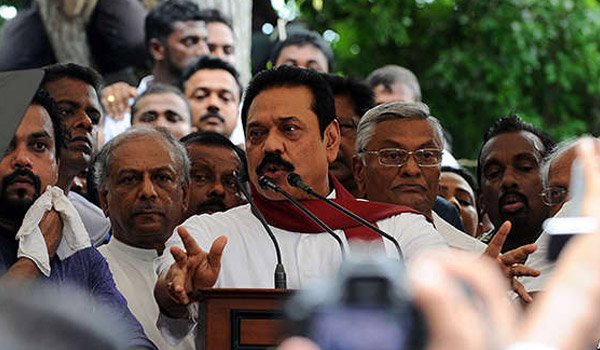Until this year Mahinda Rajapaksa had seemed invincible: a war-winning president who had changed the constitution to give himself the right to stand for unlimited terms. Then in January, to almost universal surprise, he was beaten at the polls by a renegade member of his own party. It was a stunning defeat for Mr Rajapaksa, who was expected to take it as his cue to retire. Instead, in the six months since Maithripala Sirisena took office as president, Mr Rajapaksa has emerged as his principal headache.
On Wednesday he blossomed into a throbbing migraine. With an elaborately staged appearance broadcast from his hometown, Mr Rajapaksa (pictured above) declared his intention to re-enter politics. He says he will lead his loyalists in a snap general election called for August 17th. On the face of it Mr Rajapaksa, the president of Sri Lanka from 2005 to 2015, would enter parliament as an ordinary MP. His aim of course would be to become prime minister, but it is unclear how he could achieve that. At the moment he has fans, but no party.
In November 2014 Mr Sirisena had blindsided Mr Rajapaksa, who was then president, by quitting the government in order to contest the presidential election. His campaign capitalised on public discontent with Mr Rajapaksa’s rule. In its final years his regime had been marked by a frightening degree of authoritarianism and nepotism.
On January 8th Mr Sirisena secured 51.3% of the vote and carried the presidency. As part of his scheme to form a minority government with support from the United National Party (UNP), his first executive action was to sack the prime minister and swear in Ranil Wickremesinghe, the leader of the UNP. There was bitter irony for Mr Rajapaksa, whose Sri Lanka Freedom Party (SLFP) had counted Mr Sirisena as an ally against the UNP, their arch-enemy.
Mr Rajapaksa was praised for ensuring “a smooth transition of power” after he left the presidency. He also ceded leadership of the SLFP to Mr Sirisena—and that was supposed to be the end of the story.
In defeat Mr Rajapaksa has remained hugely popular among much of the Sinhala-speaking Buddhist majority for having destroyed the Tamil Tiger rebels in 2009. Since he left office his nationalist admirers have been busy whipping up waves of public support (often to the discomfort of the Tamil minority). Finally he seems to have been coaxed back into the arena by factions within the SLFP who resent Mr Sirisena for having forged a pact with their UNP adversaries.
The Rajapaksa loyalists had already been making life difficult for Mr Sirisena by denying him parliamentary support. They floated various no-confidence motions, including one against the new prime minister, Mr Wickremesinghe. Despite their interference Mr Sirisena managed to push through a constitutional amendment to reintroduce a two-term limit on the presidency. He whittled down some of the president’s powers too, but his efforts to overhaul the voting system were stymied. His promises to build a leaner government, with fewer entitled ministers, came to nought. A right-to-information bill never made it to parliament.
In late May Mr Wickremesinghe declared in frustration that “parliament is dead”. Weeks of backroom negotiations followed. The two rivals, president and former president, even met face-to-face. To no avail: on June 26th Mr Sirisena gave up and dissolved the assembly. The bargaining continues.
Onto this stage strode Mr Rajapaksa, declaring his comeback. But he faces a fundamental problem. He and Mr Sirisena are both from the SLFP, the dominant party in the United People’s Freedom Alliance (UPFA). Since attaining the presidency Mr Sirisena has led the party, and it is his prerogative to approve its candidates. He may be under intense pressure to nominate Mr Rajapaksa as a contestant, but his aides say he will refuse.
Nominations are due by July 12th. If Mr Rajapaksa is not allowed to stand for the SLFP, he could choose to lead a new alliance made up of breakaways and various parties representing his nationalist allies. It would be an uphill fight, but not necessarily a futile one. He is a powerful orator and would once again tout his wartime victory while drumming up fears of a Tamil Tiger revival—a proven formula for firing up his base.
For now Mr Sirisena heads a splintered coalition and a divided party. He has been a member of the SLFP for four decades; it must hurt to lead them to the polls against the UNP in a relatively weakened condition. But having been elected to keep Mr Rajapaksa at bay, Mr Sirisena has little choice.
(economist.com)






